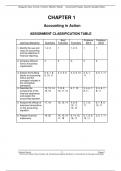Weygandt, Kieso, Kimmel, Trenholm, Warren, Novak Accounting Principles, Seventh Canadian Edition
CHAPTER 1
Accounting in Action
ASSIGNMENT CLASSIFICATION TABLE
Brief Problems Problems
Learning Objectives Questions Exercises Exercises Set A Set B
1. Identify the use and 1, 2, 3 1 1, 2, 5 1 1
users of accounting
and the objective of
financial reporting.
2. Compare different 4 2 3, 2 2
forms of business
organization.
3. Explain the building 5, 6, 7, 8, 3, 4, 5, 6 4, 5, 9, 10 2, 5, 7, 2, 5, 7, 11
blocks of accounting: 9, 10, 11 11
ethics and the
concepts included in
the conceptual
framework.
4. Describe the 12, 13, 14. 7, 8, 9, 6, 7, 13 3, 4, 6, 7, 3, 4, 6, 7,
components of the 15, 16 10, 11, 15 8, 11 8, 11
financial statements
and explain the
accounting equation.
5. Analyze the effects of 17, 18 12, 13, 14 5, 8, 9, 5, 7, 8, 6, 7, 8, 9,
business transactions 10, 11, 11 10, 11
on the accounting 12, 13
equation.
6. Prepare financial 19, 20 14, 15, 16 9, 14, 15, 6, 7, 8, 9, 2, 5, 7, 11
statements. 17, 18 16, 17 10, 11
Solutions Manual 1-1 Chapter 1
© 2016 John Wiley & Sons Canada, Ltd. Unauthorized copying, distribution, or transmission of this page is prohibited.
,Weygandt, Kieso, Kimmel, Trenholm, Warren, Novak Accounting Principles, Seventh Canadian Edition
ASSIGNMENT CHARACTERISTICS TABLE
Problem Difficulty Time
Number Description Level Allotted (min.)
1A Identify users and use of accounting information. Simple 15-20
2A Determine forms of business organization and Simple 15-20
types of accounting standards.
3A Determine missing items. Moderate 20-25
4A Classify accounts and prepare accounting Simple 20-30
equation.
5A Assess accounting treatment. Moderate 20-25
6A Analyze transactions and calculate owner’s equity. Simple 35-45
7A Analyze transactions and prepare balance sheet. Simple 40-50
8A Analyze transactions and prepare financial Moderate 40-50
statements.
9A Prepare financial statements. Simple 35-45
10A Determine missing amounts, and comment. Moderate 35-45
11A Discuss errors and prepare corrected balance Moderate 45-55
sheet.
1B Identify users and use of accounting information. Simple 15-20
2B Determine forms of business organization and Simple 15-20
types of accounting standards.
3B Determine missing items. Moderate 20-25
4B Classify accounts and prepare accounting Simple 20-30
equation.
5B Assess accounting treatment. Moderate 20-25
6B Analyze transactions and calculate owner’s equity. Simple 35-45
7B Analyze transactions and prepare balance sheet. Simple 40-50
8B Analyze transactions and prepare financial Moderate 40-50
statements.
9B Prepare financial statements. Simple 35-45
10B Determine missing amounts, and comment. Moderate 35-45
11B Discuss errors and prepare corrected balance Moderate 45-55
sheet.
Solutions Manual 1-2 Chapter 1
© 2016 John Wiley & Sons Canada, Ltd. Unauthorized copying, distribution, or transmission of this page is prohibited.
,Weygandt, Kieso, Kimmel, Trenholm, Warren, Novak Accounting Principles, Seventh Canadian Edition
BLOOM’S TAXONOMY TABLE
Correlation Chart between Bloom’s Taxonomy, Learning Objectives and End-of-
Chapter Material
Evaluat
Learning Objective Knowledge Comprehension Application Analysis Synthesis ion
1. Identify the use and Q1-3 Q1-1 P1-1A
users of accounting BE1-1 Q1-2 P1-1B
and the objective of E1-5 E1-1
financial reporting. E1-2
2. Compare different Q1-4 P1-2A
forms of business BE1-2 P1-2B
organization . BE1-4 P1-11B
BE1-10
E1-3
E1-7
3. Explain the building Q1-6 Q1-5 P1-2A BE1-3
blocks of accounting: Q1-7 Q1-8 P1-2B
ethics and the E1-5 Q1-9 P1-3A
concepts included in Q1-10 P1-3B
the conceptual Q1-11 P1-7A
framework. BE1-4 P1-7B
BE1-5 P1-11A
BE1-6 P1-11B
E1-4
E1-9
E1-10
P1-5A
P1-5B
4. Describe the Q1-12 BE1-7 BE1-8
components of the Q1-13 BE1-9
financial statements Q1-14 BE1-10
and explain the Q1-16 BE1-14
accounting equation. BE1-11 BE1-15
E1-6
E1-7
E1-13
P1-4A
P1-4B
P1-6A
P1-6B
P1-7A
P1-7B
P1-8A
P1-8B
P1-11A
P1-11B
Solutions Manual 1-3 Chapter 1
© 2016 John Wiley & Sons Canada, Ltd. Unauthorized copying, distribution, or transmission of this page is prohibited.
, Weygandt, Kieso, Kimmel, Trenholm, Warren, Novak Accounting Principles, Seventh Canadian Edition
BLOOM‘S TAXONOMY TABLE (Continued)
Evaluat
Learning Objective Knowledge Comprehension Application Analysis Synthesis ion
5. Analyze the effects Q1-19 Q1-17 Q1-18
of business E1-5 Q1-20 BE1-12
transactions on the E1-8 BE1-13
accounting equation. E1-9 BE1-14
E1-10 E1-12
E1-11 E1-13
P1-5A P1-7A
P1-5B P1-7B
P1-8A
P1-8B
P1-11A
P1-11B
6. Prepare financial Q1-19 BE1-15 P1-10A
statements. Q1-20 BE1-16 P1-10B
E1-9 BE1-17
BE1-18
E1-14
E1-15
E1-16
E1-17
P1-6A
P1-6B
P1-7A
P1-7B
P1-8A
P1-8B
P1-9A
P1-9B
P1-11A
P1-11B
Broadening Your BYP1-1 Santé Saga BYP1-3 BYP1-4 BYP1-2
Perspective BYP1- 6 BYP1-5
Solutions Manual 1-4 Chapter 1
© 2016 John Wiley & Sons Canada, Ltd. Unauthorized copying, distribution, or transmission of this page is prohibited.




